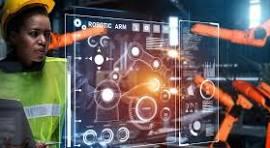Revolutionizing Workplace Safety: A Tech Evolution
Stanley Bangani![]() Invalid date
4 minutes, 19 seconds
Invalid date
4 minutes, 19 seconds
419 views 2 Likes
Introduction:
Workplace safety has always been a top priority for organizations across the globe. In recent years, technology has played a pivotal role in transforming the landscape of workplace safety, making it more efficient, proactive, and responsive. This blog explores the cutting-edge tech innovations that are reshaping the way we approach safety in the workplace.
IoT-enabled Wearables:
One of the most significant advancements in workplace safety is the integration of Internet of Things (IoT) technology into wearable devices. Smart helmets, vests, and glasses equipped with sensors can monitor various environmental factors and the health of the wearer in real-time. For instance, these wearables can detect hazardous gases, monitor heart rates, and even alert workers if they are entering restricted zones.
Augmented Reality (AR) for Training:
AR technology has revolutionized training programs by providing immersive and interactive experiences. In the realm of workplace safety, AR is being used to simulate hazardous scenarios, allowing workers to practice emergency procedures in a controlled environment. This not only enhances their skills but also boosts confidence in handling real-life situations.
Drones for Surveillance:
Drones have become indispensable tools for monitoring and inspecting large industrial sites. Equipped with cameras and sensors, drones can navigate through challenging terrains and capture high-resolution images or videos of potential safety hazards. This enables organizations to conduct thorough inspections without putting human lives at risk.
Machine Learning Predictive Analytics:
Machine learning algorithms are increasingly being employed to analyze historical data and identify patterns that can predict potential safety issues. These predictive analytics tools can forecast equipment failures, detect emerging hazards, and suggest preventive measures. By leveraging these insights, organizations can proactively address safety concerns before they escalate.
Robotics for Hazardous Tasks:
Robots are being deployed for tasks that pose significant risks to human workers. In environments with potential exposure to toxic substances or extreme conditions, robots can perform tasks such as inspection, maintenance, and clean-up. This not only protects human workers but also improves the efficiency of these processes.
Real-time Communication Platforms:
Communication is a key component of workplace safety. Real-time communication platforms, such as instant messaging apps and collaborative tools, enable quick and efficient information sharing among team members. In emergency situations, these platforms facilitate swift communication, ensuring that everyone is informed and can take appropriate actions promptly.
Biometric Access Control:
Biometric technology is enhancing access control measures in workplaces. By implementing fingerprint or facial recognition systems, organizations can ensure that only authorized personnel have access to specific areas. This not only prevents unauthorized entry but also enhances security and safety within the workplace.
Conclusion:
As technology continues to advance, so does our ability to create safer working environments. The integration of IoT, AR, drones, machine learning, robotics, communication platforms, and biometrics represents a comprehensive approach to workplace safety. By embracing these innovations, organizations can significantly reduce the risk of accidents, protect their workforce, and create a culture of safety that is proactive and responsive to evolving challenges. The future of workplace safety lies in the hands of technology, driving us toward a safer and more secure working world.
image source:https://medium.com/@sensorisafety/transforming-workplace-safety-harnessing-emerging-technologies-for-hse-excellence-e27d23ce4881

